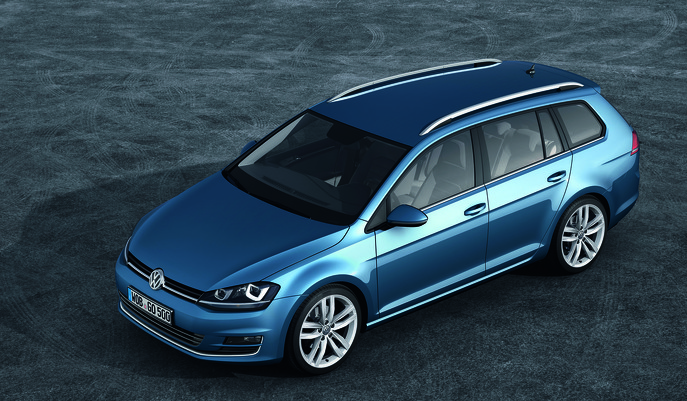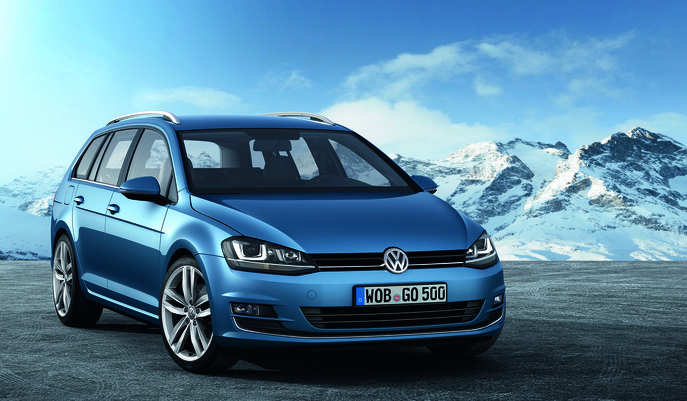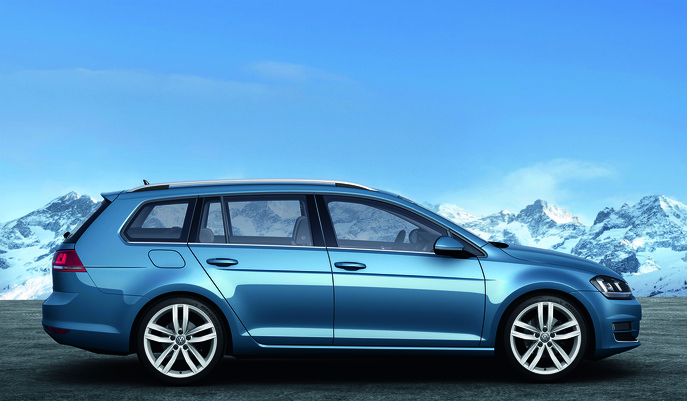Volkswagen model offensive at the Geneva Motor Show

- XL1 - production version of the two-seater sets world record with 0.9 l/100 km
- Golf Estate with front-wheel drive and all-wheel drive - as TDI BlueMotion with 3.3 l/100 km
- Golf GTI - for the first time with two power levels; 220 PS and 230 PS
- Golf GTD - long-distance sports car consumes just 4.2 l/100 km
- Golf TDI BlueMotion (diesel) - with 3.2 l/100 km the most fuel-efficient Golf of all time
- Golf TGI BlueMotion (natural gas) - 3.4 kg/100 km and up to 1,360 km driving range
- Jetta Hybrid - 170 PS saloon consumes merely 4.1 l/100 km
- cross up! - new member of the New Small Family for the urban jungle
The Geneva Motor Show (4-17 March) will be the venue for the next stage of the Volkswagen model offensive. No less than six (see above) new models of the Golf - the most successful car in Europe - will take centre stage in 2013. In a series of world premieres, Volkswagen will present the new Golf Estate (with front-wheel or all-wheel drive); the extremely fuel-efficient Golf TDI BlueMotion (as hatchback version and estate car); the Golf TGI BlueMotion with natural gas drive; as well as the iconic Golf GTI and Golf GTD. In addition, Volkswagen will show the cross up!, a new member in the New Small Family, for the urban jungle. The new Jetta Hybrid and the production version of the most fuel-efficient car in the world -the XL1 - will set benchmarks for sustainability.

0.9 litres and 21 g/km CO2
- world premiere of the XL1 production version
The XL1 by Volkswagen is the most efficient of all production cars with a fuel consumption of 0.9 l/100 km. Thanks to its plug-in hybrid system, the two-seater can also be driven for up to 50 kilometres locally in pure electric mode, i.e. with zero emissions at point of use. The XL1 follows pure sports car design principles: low weight (795 kg), perfect aerodynamics (Cd 0.189) and a low centre of gravity (1,153 mm high). This gives this Volkswagen the ability to cruise on the road at a constant speed of 100 km/h using just 6.2 kW / 8.4 PS. In all-electric mode, the XL1 requires less than 0.1 kWh to cover a driving distance of over one kilometre.
Systematic lightweight construction (among other things, monocoque of CFRP), perfect aerodynamics and the plug-in hybrid system - consisting of a two-cylinder TDI (35 kW / 48 PS), the E-motor (20 kW), a 7-gear dual-clutch gearbox (DSG) and a lithium-ion battery (capacity: 5.5 kWh) - enable the XL1 to emit only 21 g/km CO2. If needed, the XL1, which reaches (electronically limited) 160 km/h, accelerates to 100 km/h in just 12.7 seconds. One thing is certain: 0.9 l/100 km fuel consumption is a peak performance unequalled up to now that illustrates how Volkswagen is redefining what is technically feasible in car making, thus bringing the future right into the present.

3.3 litres and 87 g/km CO2
- world premiere of the Golf Estate
In a world premiere, the new Golf Estate will debut at the Geneva Motor Show. It is up to 105 kg lighter than its predecessor and for the first time in the history of the Golf Estate, Volkswagen is offering this model (performance range 63 kW / 85 PS to 110 kW / 150 PS) as an extremely fuel-efficient TDI BlueMotion. The 81 kW / 110 PS estate car that comes with a 6-speed gearbox is the most fuel-efficient Golf Estate of all time, with a combined fuel consumption of 3.3 l/100 km (equivalent to 87 g/km CO2). The all-wheel Golf Estate 4MOTION will likewise be celebrating its premiere in Geneva.
The new Golf Estate is a sporty and elegant vehicle that combines low fuel consumption values and yet dynamic driving performance with great versatility. Thus the boot volume has been expanded from 505 litres to 605 litres (loaded up to the back seat backrest). Loaded up to the front seat backrests and under the roof, the new Golf Estate offers a cargo volume of no less than 1,620 litres (predecessor: 1,495 litres).
In terms of appearance, the new Golf Estate follows the precise and impressive lines of the latest Golf hatchback model up to the border of the front door. On account of the extra space between the B-pillar and the D-pillar and homogeneous visual modifications, the "classic" Golf then becomes the Golf Estate; at a length of 4,562 mm, the Golf Estate is 307 mm longer than the hatchback version. The designers succeeded in transferring the shape of the C-pillar, which is like a drawn bow and is typical of the classic Golf, to the D-pillar of the Estate; visually, the "third" side window forms a part of the D-pillar. Result: The new Golf Estate makes a more elongated, more exclusive and sportier impression than its predecessor.

6.0 litres and 139 g/km CO2
- world premiere of the Golf GTI
In tandem with the Golf GTD, Volkswagen will unveil the production version of the new Golf GTI in the trade fair hall on Lake Geneva - a double world premiere. Its body is based on that of the Golf VII, but it adopts a plethora of classic and familiar GTI design cues - first and foremost, the typical decorative red. For the first time, these stripes not only border the honeycomb-structured radiator grille but reach up into the housings of the standard xenon headlights. Volkswagen combined the superior new appearance with a premium in performance: The new Golf GTI is powered by an advanced engine from the EA888 series - a two-litre turbocharged direct-injection petrol engine with 162 kW / 220 PS. The sports car icon is optionally available in a performance-enhanced version: The engine of this Golf GTI Per-formance develops 169 kW / 230 PS.
Both GTI versions are equipped with a Stop/Start system as standard and, with a 6-speed gearbox, they attain the same low DIN fuel consumption of 6.0 l/100 km (CO2: 139 g/km). Compared to the previous model (155 kW / 210 PS), the combined fuel consumption of the Golf GTI has therefore been reduced by 1.3 litres per 100 km, or 18%! A 6-speed dual-clutch gearbox (DSG) without any interruptions in propulsive power is optional for both power levels, matching the character of the sporty icon to perfection.
4.2 litres and 109 g/km CO2
- world premiere of the Golf GTD
The GTD has been the long-distance express in the Golf range for 31 years - in a fascinating way, it combines driving fun with perfect sense, sports car performance with supermini consumption. Based on the seventh Golf generation, Volkswagen now puts the GTD in the limelight, a car whose design again follows that of the Golf GTI closely. Both the GTD and the GTI will have their debut at the Geneva Motor Show in a world premiere!
With a torque that has been raised by 30 to 380 Nm and a performance boosted by 10 kW / 14 PS to 135 kW / 184 PS, the new Golf GTD has become the most powerful production Golf turbodiesel of all time. The TDI with 6-speed gearbox and coupled to a Stop/Start system consumes only 4.2 l/100 km (CO2 emissions: 109 g/km). This means a reduction by 0.9 litres or 25 g/km CO2 in comparison to the previous model. Optionally, Volkswagen offers the GTD with a 6-speed dual-clutch gearbox (DSG) - again, a fuel consumption of 4.5 l/100 km (CO2: 119 g/km) marks the diesel as a highly efficient car. Favoured by a performance weight of 7.6 kg/PS (including driver), the Golf GTD sprints from 0 to 100 km/h in 7.5 seconds; at 230 km/h, it has reached top speed.

3.2 litres and 85 g/km CO2
- world premiere of the Golf TDI BlueMotion
With the production version of the Golf TDI BlueMotion, one of the most fuel-efficient cars of our time will make its debut in Geneva. This Golf is powered by a newly developed TDI (direct-injection turbodiesel) with 81 kW / 110 PS. The four-cylinder engine only consumes 3.2 l/100 km; this value is equivalent to CO2emissions of just 85 g/km and represents a 14% improvement in fuel economy compared to the already very fuel-efficient previous model. As mentioned above, the Golf Estate is also available as a TDI BlueMotion for the first time. With a combined fuel consumption of 3.3 l/100 km, it is one of the most fuel-efficient estate cars in the world.
Due to numerous aerodynamic modifications, the Golf TDI BlueMotion achieves an extremely low cd value both as a hatchback and estate car. The aerodynamic modifications include a lowered chassis (by 15 mm), a special roof spoiler for the hatchback version (Estate with standard spoiler in the roof area), a radiator grille that is closed to the outside, partially closed air inlet screens, optimised cooling airflow and special underfloor panels. In terms of technology, overcoming the upward weight spiral through lightweight construction, those features that are standard for all new Golf models, namely Stop/Start system and battery regeneration mode, inner-engine modifications, tyres with extremely low rolling resistance as well a wider spaced 6-speed gearbox resulted in the pioneering fuel-efficiency.
3.4 litres and 92 g/km CO2
- world premiere of the Golf TGI BlueMotion
Volkswagen utilises all modern powertrains in order to be able to offer tailor-made mobility solutions, which suit all users' requirements. Vehicles with natural-gas drive are especially clean, fuel-efficient and economical. The latest version of this pioneering drive is the Golf TGI BlueMotion. It will be launched as a hatchback in the summer and an estate car in the autumn; at the same time, Volkswagen will rechristen its natural gas "EcoFuel" models as"TGI BlueMotion" models.
The Golf TGI BlueMotion is powered by a newly developed natural-gas turbo engine (81 kW / 110 PS). The bi-fuel (designed for natural gas and petrol) 1.4 TSI facilitates impressive driving ranges: In pure CNG operation (with natural gas), the range for the version with a 6-speed manual gearbox is a good 420 km. In this mode, the car's consumption is 3.5 kg of natural gas per 100 km (equivalent to 94 g/km CO2). When petrol is also used, this adds 940 km to the car's range (fuel consumption: 5.3 l/100 km). When the two natural gas underbody tanks (together 15 kg) and the petrol tank (50 litre) are completely full, the Golf TGI BlueMotion has a range of up to 1,360 kilometres. If the Golf TGI BlueMotion is equipped with the optional 7-speed DSG, an even greater driving range is achieved thanks to a combined fuel consumption of 3.4 kg/100 km natural gas or 5.0 l/100 km petrol. As fuel-efficient as it is, the Golf TGI BlueMotion offers an agile driving performance, nonetheless: The Volkswagen accelerates from 0 to 100 km/h in 10.7 seconds. At 194 km/h, it has reached top speed.

4.1 litres and 95 g/km CO2
- world premiere of the Jetta Hybrid
The second Volkswagen with an electric motor in the drivetrain shown in Geneva is the European version of the new Jetta Hybrid. The Jetta Hybrid is powered by a high-tech petrol engine (TSI with 110 kW / 150 PS) and a 20 kW electric motor, like the one in the XL1. The gearbox is an automatic 7-speed DSG. Although this hybrid alliance facilitates a powerful driving performance (0-100 km/h in 8.6 seconds), the new Jetta Hybrid, launched in North America in late 2012, takes centre stage with a combined fuel consumption of 4.1 l/100 km (or 95 g/km CO2). This means that the sporty saloon consumes about 20% less fuel than a comparably powered car with a conventional drive system. When driving in the city, this fuel saving increases to 30%.
Whenever possible, the Jetta Hybrid uses the electric motor as sole drive source. Moreover, at the press of a button, the Volkswagen can be driven in pure electric mode, and therefore with zero emissions, at speeds of up to 70 km/h and over a distance of about 2.0 kilometres. Pre-sales of this Volkswagen, groundbreaking when it comes to fuel economy, have commenced in Germany.

4.7 litres and 109 g/km CO2
- world premiere of the cross up!
Volkswagen is expanding its range of the cross models with a new member of the New Small Family: the cross up!. The four-door vehicle will be be launched in midsummer, and the Cross range will be enriched by a city specialist. When the new cross up! joins the CrossPolo, CrossGolf and CrossTouran, no less than four individualised Volkswagen with a particularly rugged design will be available under this label.
Owing to distinctive exterior elements, the cross up! can be identified as autonomous model at first glance: From the side, black trim panels on the wheel arches and sills as well as the door protection strips all the way around make for a sporty overall impression. Other unmistakable features are silver roof rails, wing mirrors painted in "light silver metallic" and bumpers with silver highlights. The car's rugged character is also emphasised by the raised body as well as the machine-polished 16-inch light alloy wheels of the "cross" type. The 55 kW / 75 PS cross up! consumes 4.7 l/100 km (equivalent to 109 g/km CO2).
Diskusia k článku
Najnovšie galérie
































 Xavier
Xavier 
 Dani
Dani  Gilles
Gilles 
 Mathew
Mathew 
 Timo
Timo 